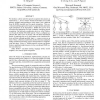Free Online Productivity Tools
i2Speak
i2Symbol
i2OCR
iTex2Img
iWeb2Print
iWeb2Shot
i2Type
iPdf2Split
iPdf2Merge
i2Bopomofo
i2Arabic
i2Style
i2Image
i2PDF
iLatex2Rtf
Sci2ools
ICASSP
2009
IEEE
2009
IEEE
A flat direct model for speech recognition
We introduce a direct model for speech recognition that assumes an unstructured, i.e., flat text output. The flat model allows us to model arbitrary attributes and dependences of the output. This is different from the HMMs typically used for speech recognition. This conventional modeling approach is based on sequential data and makes rigid assumptions on the dependences. HMMs have proven to be convenient and appropriate for large vocabulary continuous speech recognition. Our task under consideration, however, is the Windows Live Search for Mobile (WLS4M) task [1]. This is a cellphone application that allows users to interact with web-based information portals. In particular, the set of valid outputs can be considered discrete and finite (although probably large, i.e., unseen events are an issue). Hence, a flat direct model lends itself to this task, making the adding of different knowledge sources and dependences straightforward and cheap. Using e.g. HMM posterior, m-gram, and spo...
Continuous Speech Recognition | Direct Model | ICASSP 2009 | Signal Processing | Speech Recognition |
| Added | 21 May 2010 |
| Updated | 21 May 2010 |
| Type | Conference |
| Year | 2009 |
| Where | ICASSP |
| Authors | Georg Heigold, Geoffrey Zweig, Xiao Li, Patrick Nguyen |
Comments (0)

